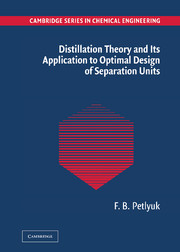Book contents
- Frontmatter
- Contents
- Preface
- Acknowledgements
- Nomenclature
- 1 Phase Equilibrium and Its Geometric Presentation
- 2 Basic Concepts of Distillation
- 3 Trajectories of Distillation in Infinite Columns Under Infinite Reflux
- 4 Trajectories of Thermodynamically Reversible Distillation
- 5 Distillation Trajectories and Conditions of Mixture Separability in Simple Infinite Columns at Finite Reflux
- 6 Distillation Trajectories in Infinite Complex Columns and Complexes
- 7 Trajectories of the Finite Columns and Their Design Calculation
- 8 Synthesis of Separation Flowsheets
- Short Glossary
- Index
- References
3 - Trajectories of Distillation in Infinite Columns Under Infinite Reflux
Published online by Cambridge University Press: 08 August 2009
- Frontmatter
- Contents
- Preface
- Acknowledgements
- Nomenclature
- 1 Phase Equilibrium and Its Geometric Presentation
- 2 Basic Concepts of Distillation
- 3 Trajectories of Distillation in Infinite Columns Under Infinite Reflux
- 4 Trajectories of Thermodynamically Reversible Distillation
- 5 Distillation Trajectories and Conditions of Mixture Separability in Simple Infinite Columns at Finite Reflux
- 6 Distillation Trajectories in Infinite Complex Columns and Complexes
- 7 Trajectories of the Finite Columns and Their Design Calculation
- 8 Synthesis of Separation Flowsheets
- Short Glossary
- Index
- References
Summary
Introduction
Our main purpose is to understand which column sequences can be used in order to get the necessary products. This task is called the task of sequencing (synthesis). The sequencing task is being solved in consecutive order beginning with the first distillation column, where initial n-component mixture comes to. For each column, it is necessary to determine feasible splits.
As a rule, our task is to separate this mixture in a few distillation columns into pure components (perhaps, with the addition of subsidiary components – entrainers, or using, besides distillation, other methods of separation). That is why we are first interested in the sharp splits in each column, when each product of the column contains a number of components smaller than the feeding of the column. The finite number of sharp splits makes determining the sharp splits quite clear and definite.
The important advantage of mixture separability analysis for each sharp split consists of the fact that this analysis, as is shown in this and three later chapters, can be realized with the help of simple formalistic rules without calculation of distillation. A split is feasible if in the concentration space there is trajectory of distillation satisfying the distillation equations for each stage and if this trajectory connects product points. That is why to deduct conditions (rules) of separability it is necessary to study regularities of distillation trajectories location in concentration space.
- Type
- Chapter
- Information
- Publisher: Cambridge University PressPrint publication year: 2004



